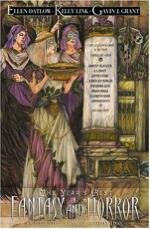

The Year's Best Fantasy and Horror: Eighteenth Annual Collection, edited by Ellen Datlow, Kelly Link and Gavin J. Grant
Reviewed by Geneva Melzack
St Martin's Griffin, New York, 2005, 480pp, $19.95, t/p, ISBN 0-312-34194-6
When you open this book to start reading you know two things about the stories contained within its pages: that they are classifiable as either fantasy or horror, and that they are good enough for someone to have considered them the best stories of 2004. Whether knowing these two things enhances the stories collected in The Year's Best Fantasy and Horror depends very much upon the individual story.
For the stories that are merely good rather than outstanding, the appellation 'best' probably does them a disservice. A good story that sits alongside stories that really are the best may not come off quite as well as it perhaps did in its original context of publication. Simon Brown's 'Water Babies,' for example, is a well-written and engaging story that unfortunately reads as being a little bit flat in comparison to some of the more innovative and imaginative stories in the collection. But this is a minor hazard for this sort of anthology, and I would rather be given the opportunity to encounter these stories than not, because they are indeed worth reading, and the odds are you wouldn't come across them at all if you were reading independently. The diversity of the markets from which the stories have been collected is striking, and the fact that the collection is edited by three people only emphasises how difficultperhaps impossibleit is for a single reader to keep up with all the short fiction being published at the moment.
The classification of these stories as being fantasy and/or horror could be seen as a narrowness of scope, an attempt to wall fantasy and horror up into the genre ghetto. But again, the diversity of the markets these stories have been taken from belies this argument. Datlow, Link and Grant haven't just looked at fiction published under the banner of fantasy and horror; they've also included stories originally published in mainstream or young adult markets. Indeed, publishing stories such as Chuck Palahniuk's 'Guts'originally published as mainstream fictionin a fantasy and horror collection actually adds an extra layer to the story, which provides a new method for appreciating it. In any other context I think I may have been tempted to dismiss 'Guts' as just a shock-piece, out to disgust readers for no good reason. But publishing the story as horror made me appreciate that sometimes the very point of fiction is to provoke extreme emotional reactions in readersthat's what horror fiction is fundamentally aboutand reading 'Guts' in this light helped me to find some value in what it was trying to do.
Some of the best contemporary fantasy and horror fiction, it seems, is being written for young people. A couple of the most striking and effective stories in the collection are stories that were written by authors who mostly write for a young adult readership, or at least, that is the audience their writing is targeted at. Margo Lanagan has two stories in The Year's Best Fantasy and Horror, 'Rite of Spring' and 'Singing My Sister Down,' both from her young adult story collection Black Juice. Children's author M. T. Anderson's story 'Watch and Wake' is also included as one of the best fantasy and horror stories of 2004. There's something particularly visceral about these three stories, a physicality in the way the worlds of the stories are imagined and in the way the fantastic/horrific elements emerge out of those worlds. They are stories that pull the reader in, vividly situating them inside the experiences of the protagonists. This sense of tangibility is highly effective at engaging the reader, making them feel the sadness or the fear that the characters in the stories are feeling, creating an atmosphere in which the fantastic or the horrific flourishes.
There is still some exciting and innovative fantasy and horror fiction being written for adults, though it seems to be rarer than one might hope. The two stories here that are most interesting and imaginative are China Miéville's 'Reports of Certain Events in London,' which is an account of the movements of 'feral streets' and Stepan Chapman's 'Revenge of the Calico Cat,' a surreal story set in a world populated with plush toys. The Year's Best Fantasy and Horror isn't just a short story collection, however, it is also a comprehensive survey of the fantasy and horror genres in 2004, covering novels, films and television, comics and graphic novels, anime and manga, music, and obituaries, as well as a full index of notable fantasy/horror publications, and as such is as much of a reference book as it is a fiction one. As with the short fiction presented here, editors Datlow, Link and Grant have taken a very broad approach, and the works reviewed come from a wide variety of markets and sources.
This collection succeeds on the basis of its openness and willingness to embrace a diverse range of exciting fiction, whatever its supposed target audience. The bulk of the stories in the collection that come from established fantasy and horror authors and markets can sometimes feel repetitive, giving the impression that the genres are stagnating somewhat. However, this sense of malaise is transcended by a clutch of individual stories that succeed on the strength of the skill and artfulness with which they're written, or because of their spark and originality, regardless of the market they were originally written for or targeted at.
This article first appeared in Vector 246. Back issues of Vector are available from
